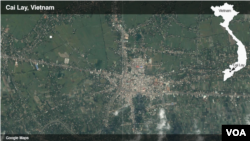It has not received a lot of attention outside of Vietnam, but almost every day for weeks, the topic on the front pages of newspapers has been truckers and other drivers who refused to pay a traffic toll in Vietnam and who, in doing so, became a nationwide symbol of much broader frustration with authorities.
Vietnamese citizens have been drawn to the revolt at Cai Lay, a provincial district some 96 kilometers southwest of Ho Chi Minh City where drivers feel they have been charged an unfair toll. What began as truck drivers' frustration over a road fee escalated to the level of a national crisis, with the prime minister finally stepping in to suspend the fee for further consideration from the government.
Now the Ministry of Transportation has set a deadline of Dec. 22 to review proposals to resolve the impasse.
Observers took vicarious satisfaction in the truckers’ victory, especially as other, more political forms of protest have not met with as much success, such as public displays of displeasure at Beijing’s territorial claims in the combustible South China Sea.
Now, when Vietnamese say “BOT,” it is shorthand for this particular act of roadside resistance. It refers to BOT Cai Lay, the “build, operate, transfer” bypass built by the National Highway No. 1 Tien Giang Investment Company, with eventual plans to transfer it to the Vietnamese government. The bypass runs parallel to a popular road linking the Mekong Delta and the southern business center of Ho Chi Minh City. The investor also spent money upgrading the original road, so it erected a toll station there.
But opponents viewed this as a cash grab, feeling they had to pay a new fare on the old road, even though they didn’t use the new bypass.
Drivers responded creatively.
While some parked and insisted outright that they would not be paying the new fee, others bogged down toll collectors by demanding exact change in 100-Vietnam dong notes, an amount that very few people carry, or by paying their fees with small notes. The civil disobedience dragged on for days and was notable in the level of solidarity among the drivers who frequent this route.
It created so many delays that toll collectors were forced to waive the fee multiple times throughout any given day and wave drivers through for free, for hours, to relieve the bottle-neck.
“The prime minister [Nguyen Xuan Phuc] emphasized that there are issues that are consistent with the law and regulatory procedure, but not properly implemented or suitable to the public, so we still have to seriously listen and seek corrective measures,” the government said on its website. While promising to resolve the Cai Lay dispute, the government added: “Economic issues absolutely cannot be allowed to turn into social unrest.”
Most Vietnamese do not feel a direct impact from the scandal, but have followed the story with obsessive interest as a rare moment when ordinary people stood up to the system and won.
Mass demonstrations often do not spread very far, but this time Hanoi mostly did not get in the way of drivers, instead seeming to leave a pressure valve open and allow citizens to let off some steam.
Still the government said it took note of 14 vehicles that appeared to drive back and forth through the toll booth in order to “cause confusion.”
Blogger Le Nguyen Huong Tra responded in what looked like a defense of the drivers.
“Roads can be crossed and groups and individuals have the right to cross them if the roads are not blocked,” she said in a Facebook post. “If it is not proven that that action is controlled by a regulatory law, then it can not be seen as a violation.”







